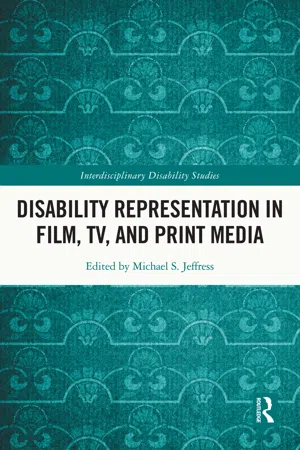
- 280 pages
- English
- ePUB (mobile friendly)
- Available on iOS & Android
Disability Representation in Film, TV, and Print Media
About this book
Using sources from a wide variety of print and digital media, this book discusses the need for ample and healthy portrayals of disability and neurodiversity in the media, as the primary way that most people learn about conditions.
It contains 13 newly written chapters drawing on representations of disability in popular culture from film, television, and print media in both the Global North and the Global South, including the United States, Canada, India, and Kenya. Although disability is often framed using a limited range of stereotypical tropes such as victims, supercrips, or suffering patients, this book shows how disability and neurodiversity are making their way into more mainstream media productions and publications with movies, television shows, and books featuring prominent and even lead characters with disabilities or neurodiversity.
Disability Representation in Film, TV, and Print Media will be of interest to all scholars and students of disability studies, cultural studies, film studies, gender studies, and sociology more broadly.
Frequently asked questions
- Essential is ideal for learners and professionals who enjoy exploring a wide range of subjects. Access the Essential Library with 800,000+ trusted titles and best-sellers across business, personal growth, and the humanities. Includes unlimited reading time and Standard Read Aloud voice.
- Complete: Perfect for advanced learners and researchers needing full, unrestricted access. Unlock 1.4M+ books across hundreds of subjects, including academic and specialized titles. The Complete Plan also includes advanced features like Premium Read Aloud and Research Assistant.
Please note we cannot support devices running on iOS 13 and Android 7 or earlier. Learn more about using the app.
Information
1 Parasocial contact effects and a disabled actor in Speechless
1.1 Disabled people in entertainment media
1.1.1 Speechless
It was important to me that we cast someone with a disability because first of all; just for the reality of the show, we didn’t want to be faking it. And to do a show about inclusion and to get it wrong so fast … I didn’t want to mess it up in the most obvious way. Because the show has found a home on the network, I am hoping that experience will be replicated, because people are seeing that these stories are stories that can find an audience.(Haller, 2016)
‘It was really helpful asking Eva what kind of things she’d like to see on the show, but also what kinds of things she didn’t want to see,’ Silveri says. ‘She was the one who turned me on to inspiration porn,’ the concept of relegating a person with a disability into a source of inspiration simply by virtue of their existence. ‘This show brought that to the masses; I’d be lying if I said I was even aware of that a year ago.’(Rosen, 2017, p. 28)
Often, characters with disabilities are either inspiring or they are an object of pity to make other characters look better. And I feel like with what Speechless is doing, we’re finally getting characters with disabilities who are complicated, they’re funny, sometimes they can be jerks. And it's just great to see finally characters with disabilities that have depth and nuance, because that's been one of my biggest goals is to teach people that sometimes people with disabilities and cerebral palsy can be a**holes. And I feel like I’ve done a really good job of proving that to people.(Bushman, 2017)
1.2 Research about the impact of TV actors with disabilities
Table of contents
- Cover
- Half Title
- Series Page
- Title Page
- Copyright Page
- Dedication
- Contents
- List of figures and tables
- List of contributors
- Acknowledgments
- List of abbreviations
- Introduction
- 1 Parasocial contact effects and a disabled actor in Speechless
- 2 Women with disability: Sex Object and Supercrip stereotyping on reality television’s Push Girls
- 3 A critical examination of the intersection of sexuality and disability in Special, a Netflix series
- 4 Euphemistic processes on the MDA Show of Strength Telethon, 2012–2014: The post-Jerry Lewis years
- 5 Hegemonic constructions and corporeal deviance in portrayals of physically disabled women characters on Saturday Night Live
- 6 Inspiring people or perpetuating stereotypes?: The complicated case of disability as inspiration
- 7 The patronized supercrip: A textual analysis of The Peanut Butter Falcon
- 8 How silence rhetorically constructs deafness in A Quiet Place: The silent treatment
- 9 The communication of disability through children’s media: Potential, problems, and potential problems
- 10 Discursive representations of disability in children’s picture books on disabled parents
- 11 An interrogation of select Indian literary works through disability discourse: Loud yet unheard
- 12 Abuse and/as disability in Leah Lakshmi Piepzna-Samarasinha’s Dirty River : How to speak without words
- 13 Media, culture, and news framing of disability in Kenya’s Daily Nation newspaper
- Index